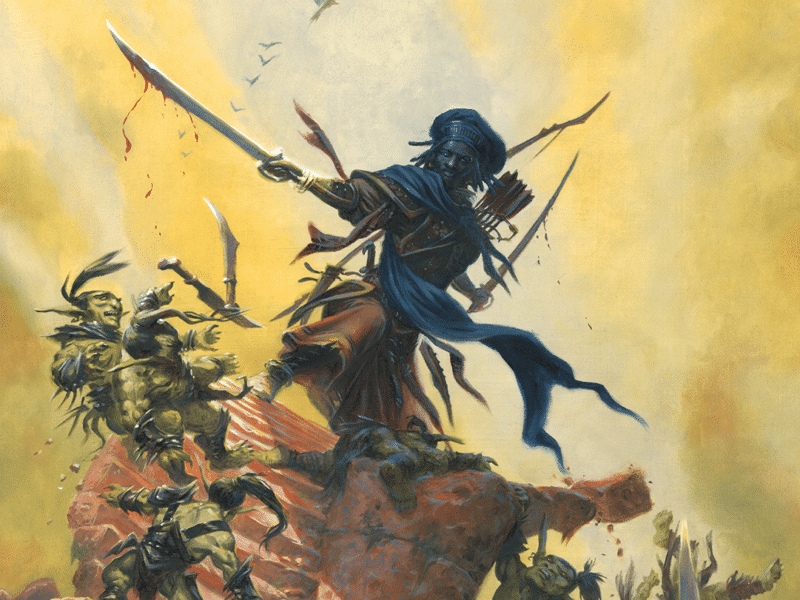So, we at Midnight Tower are currently running our ninth (9th!) successful campaign ‘The Mystery with the Cursed Statuette – A Detective Mystery Adventure Inspired by Sherlock Holmes’ for 5e on Kickstarter. Therefore, we thought it could be a good idea to share some of the knowledge, tricks and tips that we have stumbled upon along the way.
Are you a budding creator who is curious about crowdfunding?
– Then read on, for this article is for you!
Here below, we will share the best ten tips from Midnight Tower to run a Kickstarter (or any other type of crowdfunding campaign) and what you should think about before you get started.

1. Make something awesome
This is a straightforward recommendation, but one that some people actually miss. Think about what you want to do – but also consider if your book or product has an interested audience.
You can either try to attract a broader audience, or a more niche audience. Both options have their own pros and cons, but in general the most important part is to make something awesome!
An amazing RPG book filled with fantasy illustrations and exciting adventures is something that attracts plenty of people, but a thin fanzine with no illustrations and complex rules for a weird system that no one has ever heard of… might not be equally popular.
Don’t clone other ideas or projects. A book called ‘The Curse of Vlaad’ that is about a vampire in Burovia is unoriginal. There is nothing wrong with getting inspired by other projects or books, but make something awesome that you are excited about and make it your own!
2. Have a reasonable goal
A mistake that a lot of new Kickstarter creators make is to set a high funding goal. The higher goal you have, the higher is the risk that you won’t get your project funded. And since around 60% of Kickstarter campaigns fail, you want to stack the odds in your favour.
Therefore, if this is your first campaign, aim at a low target goal. If you reach your goal, you can start adding stretch goals that can be used for commissioning more art and content.
The best way to keep your goal low is to keep your costs low. This could mean that you might make a lot of the work yourself, for example writing and drawing illustrations, as well as asking friends to help you with design layout, proofreading, etc.
3. Keep pledge levels reasonable
Let’s say that you have made an amazing project with a reasonable goal (Well done, you!). The next thing that could either lead to that someone decides to back your project or decides against it is your pledge cost.
Keep your pledge costs reasonable if you want people to back your project. There are PDFs from $1 to $20, so find a sweet spot somewhere in between. If your project is small, don’t overcharge, especially if you are new to Kickstarter.
When it comes to printed books, you need to make a budget. Oh, the horror. Get over it.
This isn’t that complicated, all you need to figure out is: a) How much will Kickstarter charge, b) What are the printing costs, c) What is the average production cost of your book, and d) How much is shipping.
If this sounds intimidating and if you don’t like math: Get someone to help you. Ask a friend to go through it together with you.
As a general rule, keep pledge levels low, but make sure that you can afford to actually make the book or tabletop game. If you like, I would also recommend having a ‘Low income pledge reward’. We have offered this option since our first campaign and it is a nice way to let people who don’t have that much money (for example students) be able to participate in the campaign. We also offer this reward to veterans, NHS hospital and care home staff, and first responders, because they are awesome people!
4. Have a nice project picture
A thumbnail of your project works like a poster or a nice book cover. It will draw attention to the project and it is the first thing a potential backer will see. So, make it pretty and make it awesome!
Don’t drown the thumbnail with text and try to keep logos or other symbols to a minimum.
Pro-tips: Use a good colour scheme with nice contrasts and depth. Make sure that the thumbnail picture either showcases what your project is about or that it conveys the theme of your project. For example: If your project is about raising funds to create an RPG book: Show a 3D picture of the book with the cover on the thumbnail. If your project is a tabletop game with Lovecraftian and cosmic horror theme: Show your potential backers some kick-ass cool artwork with horror vibes and tentacles.
There is nothing that stops you from doing both, but make sure the project thumbnail doesn’t become too cluttered. In fact, a good idea is to go through current Kickstarter projects within your niche and rate them on a scale 1-5. Write down three good things and three bad things about ten projects, and you got a list of things that you should avoid or embrace.
It goes without saying that you shouldn’t copy other people’s thumbnails or pictures, but it’s okay to use them as references for text placement, font size, bleed areas, etc.)
5. Make a video
You don’t have to make a video – but it helps tremendously. This is your window to present your project and yourself in a way that photos or still pictures can’t.
Even if you don’t have any fancy equipment, you can film yourself talking about the project and add some artwork. If you know how to make a TikTok video or Instagram Story you can do this.
Think about the video like a movie trailer. Keep it relatively short (45 seconds to 1 minute is perfect) and make sure that it tells the viewer what the project is about.
It is also great if you can show some pretty art and add music to the video. A neat little intro (and outro) is also nice. As with the thumbnail picture, have a look at what other people have done and get inspired.
My best tip here is to film yourself when you talk about the project. If you are nervous and camera shy, do it anyway. I fretted endlessly about this when we did our first videos, but it is incredibly valuable.
What you need to know is: You don’t have to be a charismatic voice actor to pull this off. In fact, even the most super-nervous geek, but who is passionate about their project, will excel at this. Because you don’t have to be a smooth-talking door seller, you just have to be yourself. People at Kickstarter like personal and quirky projects, by personal and quirky persons.
6. Art, art, art!
If you can, try to get your hands on some of the art for the project beforehand. Don’t splash out a fortune on commissioned art, if this is your first project, but make sure that you got some nice art to show. If you can’t afford commissioned art, look for personal artwork on DeviantArt or Instagram and reach out. If it is a personal artwork and you are nice, people might be willing to offer you to use their art for a reasonably low price.
If you are on a limited budget, make your illustrations yourself, ask a friend to help you, or buy stock pictures. Never ever steal art or download ‘free art’ from dubious sources. It is morally wrong, illegal, and you can get into a lot of trouble about it.
It is much better to support fantasy artists, make your own illustrations, or ask a friend to help you.
If your project gets funded, you can start splashing out on art, but it is good to have a couple of really nice pieces of artwork to show on the project page. A lot of creators make the mistake of writing too much text about the campaign on the project page. It is much better to have pretty eye-candy pictures and show what the project is about. 3D pictures of the book, open pages, and other mock-up pictures is also a good idea to get the backer imagine what the finished book or tabletop game might look like.
Also, don’t forget about the presentation: Add pledge pictures with rewards and have nice picture headlines instead of a wall of text and bolded headlines. (No one likes that.)
7. Do you have to have a huge following on social media?
No.
Having said that, it probably helps, but it won’t impact your project unless you have a huge following on social media. Most of the backers will find your project directly on Kickstarter’s website. In fact, when we launched our first Kickstarter back in 2019, 84% of all backers came from Kickstarter.
If you want to gain a larger audience, it is so much better to set up a newsletter to collect people’s email addresses. I can’t recommend this enough. Having a way to contact people who are interested in your books/ tabletop games or future campaigns is gold.
What about advertising, then?
If this is your first crowdfunding campaign, I wouldn’t spend money on it. Advertising is a whole different beast and it can easily consume all your time and effort, in my opinion. If you want to spread the word, there are other ways that are cheaper and more fun as well…
8. Collaboration and cross-promotion
… Which leads us to collaborating with other creators and cross-promotion!
This is one of my favourite ways to help spread the word about my project – and get in contact with other creators.
Collaborations are wonderful, this could be commissioned art or exchanging information with other creators. This is so useful, and fun too! I have met so many wonderful people since we started publishing our adventures and some of them have become my friends too!
‘But what is cross promotion?’ I hear you say.
The best type of cross-promotion is directly on Kickstarter. Reach out to other creators that are running a Kickstarter and ask if they are interested in running a cross-promotion in an update.
At the end of your update, you write a little bit about their project, add their thumbnail image, and a link to their projects. The other creator will do the same thing in return.
Choose your cross-collaboration projects carefully. In my opinion, the projects should be quite similar or in the same niche. For example, we make 5e adventures, and cross-promoting with other 5e projects or roleplaying adventures works great. However, running a cross-promotion with a project that does miniatures, comic books, or dice, doesn’t work as well.
Try to do only one cross-promotion per update, because otherwise it can appear spammy.
We usually cross-promote with both smaller and larger projects during a campaign. It is fun helping smaller projects, while larger projects will give us a better boost. But it isn’t about getting more funding or backers – it is about creating a community and helping each other.
9. Communicate with your backers and fans
Just like other creators can help you spread the word about your campaign, so can your backers and fans. Some people claim that you shouldn’t write updates too often, because it can lead to that people cancel their pledges, but I disagree.
I think you should write updates, encourage comments, and reply to every email as much as you can (without getting burned out, of course).
In addition, try to engage with your backers: Ask them for their suggestions, let them vote for content or names in your book, or come up with ideas for stretch goals. A lot of cool ideas from backers have made it into our books.
It is a way to show your backers that you care about them and let them know how the project is evolving and moving forward. Let them see artwork sketches, behind the scenes, film silly interview videos, and celebrate milestones together. Your backers are wonderful people, so let them be involved in your project as much as possible!
10. Be personal
As we talked about earlier, even if you are camera-shy, nerdy, and introverted, try to crawl out of your shell a little bit. Being personal and showing the world how passionate and interested you are in your project is so important. Be honest about your expectations and that you might be afraid of failing, even if it is hard.
Asking people to help you with your project is dead scary. It is the Horrible Fear of Rejection that hunts us all. But, in my opinion, people are remarkably kind. In addition, most people who are searching for projects at Kickstarter really are there because they want to find nerdy projects that they can help come alive. And that is, as Gandalf would have said: ‘And that is an encouraging thought’!
Kickstarter is a crowdfunding platform that allows individuals or businesses to raise funds for creative projects. Project creators set a funding goal and a deadline, and then they launch a campaign on Kickstarter to promote their project. People who are interested in supporting the project, called backers, can pledge money to the campaign. If the funding goal is met by the deadline, the project is considered successfully funded, and the creator receives the pledged funds to bring their project to life. However, if the goal is not reached, no funds are collected, and the project is not funded.
While Kickstarter offers opportunities for funding creative projects, there are a few downsides to consider. First, there is no guarantee that a project will be completed or delivered as promised. Kickstarter operates on a trust-based system, and there have been instances where projects have faced delays, failed to deliver rewards, or even abandoned altogether. Additionally, not all projects are successful in reaching their funding goals, which means that even if you back a project, there is a chance it may not receive the necessary funds to move forward.
If a Kickstarter campaign fails to meet its funding goal by the deadline, no money is collected from the backers. In such cases, the project creator does not receive any funds, and backers’ pledges are not charged or deducted from their accounts. This is one of the reasons why it’s important to thoroughly assess a project’s potential and credibility before deciding to back it on Kickstarter.
As a backer on Kickstarter, you do not make money directly from the platform. When you back a project, you are essentially providing financial support to help bring that project to life. In return, depending on the project, creators often offer rewards or incentives to their backers, such as early access to the product, exclusive merchandise, or special experiences related to the project.
There are several reasons why Kickstarter projects may fail. Some common factors include:
Lack of preparation: Some project creators may not have thoroughly planned or researched their projects, leading to unrealistic goals or poor execution.
Inadequate promotion: If a project fails to gain enough attention and support from the Kickstarter community and beyond, it may struggle to reach its funding goal.
Unforeseen challenges: Unexpected setbacks, manufacturing issues, or production delays can hinder a project’s progress and cause it to fail.
Lack of transparency: Project creators who fail to communicate openly and honestly with their backers may face a loss of trust, leading to a project’s failure.
If a Kickstarter project fails to reach its funding goal and is not successfully funded, backers do not need to provide any payment, and no money is charged or deducted from their accounts. Therefore, backers do not need to worry about getting their money back in such cases. However, if a project is successfully funded but fails to deliver on its promises, backers may have limited recourse to recover their funds, depending on the circumstances. It’s important for backers to carefully evaluate the project and creator’s credibility before deciding to support a Kickstarter campaign.







